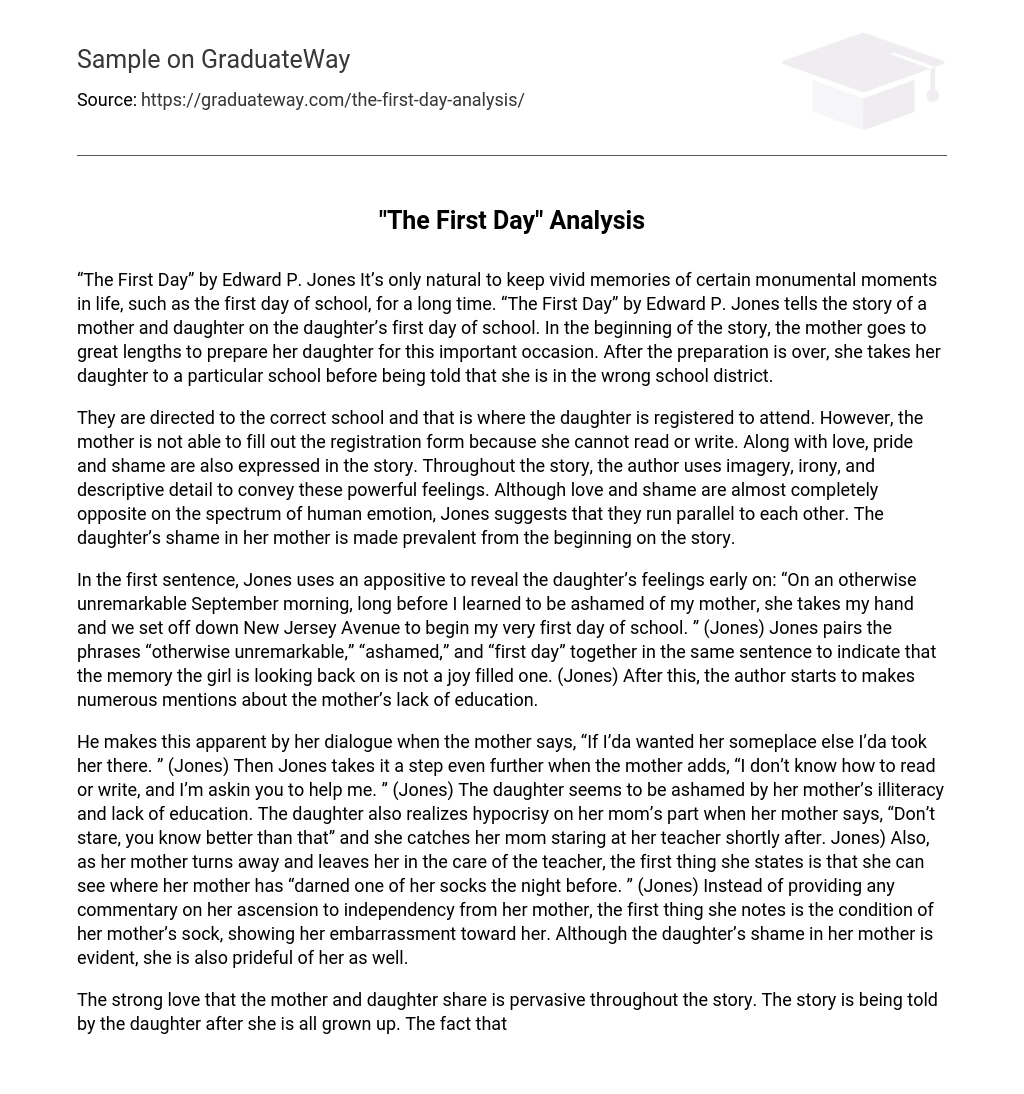“The First Day” by Edward P. Jones It’s only natural to keep vivid memories of certain monumental moments in life, such as the first day of school, for a long time. “The First Day” by Edward P. Jones tells the story of a mother and daughter on the daughter’s first day of school. In the beginning of the story, the mother goes to great lengths to prepare her daughter for this important occasion. After the preparation is over, she takes her daughter to a particular school before being told that she is in the wrong school district.
They are directed to the correct school and that is where the daughter is registered to attend. However, the mother is not able to fill out the registration form because she cannot read or write. Along with love, pride and shame are also expressed in the story. Throughout the story, the author uses imagery, irony, and descriptive detail to convey these powerful feelings. Although love and shame are almost completely opposite on the spectrum of human emotion, Jones suggests that they run parallel to each other. The daughter’s shame in her mother is made prevalent from the beginning on the story.
In the first sentence, Jones uses an appositive to reveal the daughter’s feelings early on: “On an otherwise unremarkable September morning, long before I learned to be ashamed of my mother, she takes my hand and we set off down New Jersey Avenue to begin my very first day of school. ” (Jones) Jones pairs the phrases “otherwise unremarkable,” “ashamed,” and “first day” together in the same sentence to indicate that the memory the girl is looking back on is not a joy filled one. (Jones) After this, the author starts to makes numerous mentions about the mother’s lack of education.
He makes this apparent by her dialogue when the mother says, “If I’da wanted her someplace else I’da took her there. ” (Jones) Then Jones takes it a step even further when the mother adds, “I don’t know how to read or write, and I’m askin you to help me. ” (Jones) The daughter seems to be ashamed by her mother’s illiteracy and lack of education. The daughter also realizes hypocrisy on her mom’s part when her mother says, “Don’t stare, you know better than that” and she catches her mom staring at her teacher shortly after. Jones) Also, as her mother turns away and leaves her in the care of the teacher, the first thing she states is that she can see where her mother has “darned one of her socks the night before. ” (Jones) Instead of providing any commentary on her ascension to independency from her mother, the first thing she notes is the condition of her mother’s sock, showing her embarrassment toward her. Although the daughter’s shame in her mother is evident, she is also prideful of her as well.
The strong love that the mother and daughter share is pervasive throughout the story. The story is being told by the daughter after she is all grown up. The fact that Jones uses such vivid detail on the mother’s preparation for her daughters first day of school shows that the daughter loved her mom and all that she did for her. The daughter recalls that her mother spent a lot of time preparing her when she says, “My mother has uncharacteristically spent nearly an hour on my hair that morning, plaiting and replaiting so that now my scalp tingles. (Jones) She also remembers that her “pale green slip and underwear are new, the underwear having come three to a plastic package with a little girl on the front who appears to be dancing. ” (Jones) The daughter having remembered details like these illustrate that she has an immense love and takes pride in her. Jones also uses unique sentence structure to exhibit pride in her mother. Numerous times in the story, the sentences start, “This is my mother:” showing that she is proud of what she stands for. Jones) The use of this beginning suggests that the daughter is proud of her mother and wants to make her known to the readers. Jones pairs pride and shame with each other in the story even though they are not normally corresponding feelings. In the end of the story, Jones makes numerous mentions that the girl can hear her mother’s footsteps as she walks away, leaving her at the school: “Her shoes make loud sounds in the hall,” “I can still hear the sounds of her shoes,” “I can still hear my mother’s footsteps above it all. (Jones) The author stresses this idea to signify pride in her mother – to let the readers know that part of her mother still remained with her even after she was left in the classroom. Along with the pride that is shown in the last part of the story, Jones also uses detail that suggests she is ashamed of her mother. Right as her mother goes to turn away from her, the daughter recalls that she can see where her mother darned one of her socks. This is placed in the story to imply that she is ashamed of her mother’s financial state.
Jones situates these two powerful feelings close together to propose that they run parallel. By the accurate use of imagery, word connotations, and irony, writers can make two feelings seem very similar even though they are far from the same. Jones utilizes this in his story and suggests that when there is a strong love present, there can be mixed feelings of pride and shame that seem to coincide with one another. Throughout the story, Jones creates balanced emotions of pride as well as shame in the daughter through dialogue and careful word choice.





